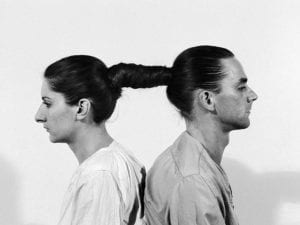As one of the central figures in performance art, using her own body as a primary material for more than 50 years, Marina Abramović needs little introduction. For the latest retrospective of a pioneering career, and its contribution to raising the status of performance art to having parity with other art forms, the Louisiana takes up the challenge of approaching this major figure by considering the theme of cleansing – the acts of catharsis, purging and transformation which are realised in Abramović’s works through using tools as diverse as fire, soapy water, screaming, time and silence.
This presentation has been developed with the artist and in collaboration with Moderna Museet, Stockholm, featuring more than 120 works from five decades including several of her most famous works as films, video, live performances, scenographies and photographs from the 1970s onwards. Several early pieces – paintings, photos, sound compositions and works on paper – are shown for the first time.
Abramović’s earlier works dealt with confrontation, pain, violence and danger, such as 1974’s Rhythm 0 in which she placed 72 objects on a table including a knife, a whip, a gun and a bullet, and allowed spectators to use them in any way they chose whilst she remained passive. In more recent years the artist has worked on long durational performance projects in which the audience has increasingly become the true principal figure – such as the three-month performance The Artist is Present at the Museum of Modern Art in New York in 2010, which saw her sit in silence for more than 700 hours.
Although her body is the subject, the object and the medium, she does not consider any particular piece to be about her as an individual, and nor is the action at the heart of each piece tied to a particular interpretation, leaving them open for reconsideration by new spectators. The exchange of energy and the act of transformation is a thread running through the entire oeuvre which is, in effect, a lifelong exploration of the physical and mental limits of the artist’s being.
Born in Belgrade in 1946, Abramović graduated from the Academy of Fine Arts in 1970 as a painter, but soon established a practice based upon direct encounters between artist and audience. She was a formative part of Belgrade’s experimental avant-garde scene until 1976, when she moved to Amsterdam and embarked on a close partnership and collaboration for the next 12 years with the German artist Ulay (Frank Uwe Laysiepen, b. 1943). As a solo artist, in 1997 she won the Main Prize, the Golden Lion, at the Venice Biennale for the work Balkan Baroque (1997), a direct response to the bloody dissolution of her native Yugoslavia, and a picture of the horror and madness of war in general. Washing a carcass in front of passing audiences, she created a conceptually rich and emotionally shocking demonstration, which still stands as an undeniably vital piece of 20th century expression.
Credits:
1. Marina Abramović, The Hero, 2001 Photo: TheMahler.com. Courtesy of the Marina Abramović Archives © Marina Abramović / Bildupphovsrätt 2017.
Louisiana Museum of Modern Art, Humlebæk. 17 June – 22 October. For more information:www.en.louisiana.dk





